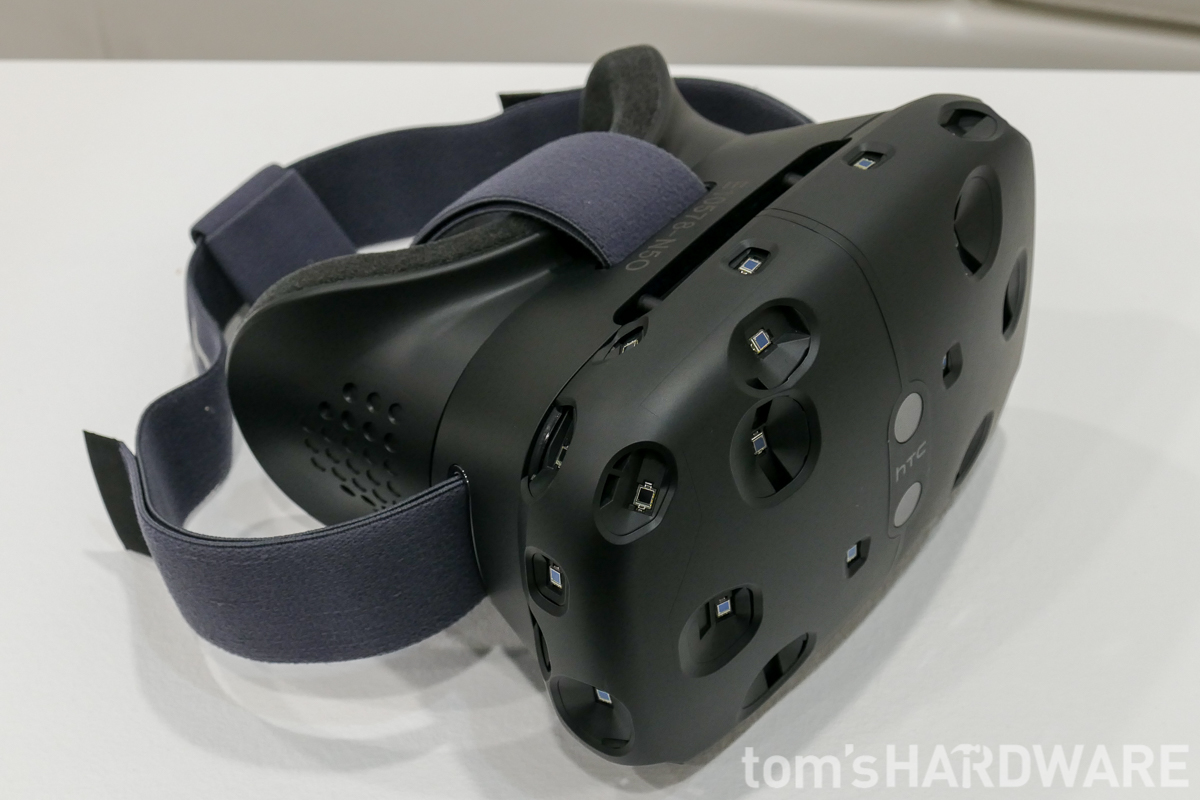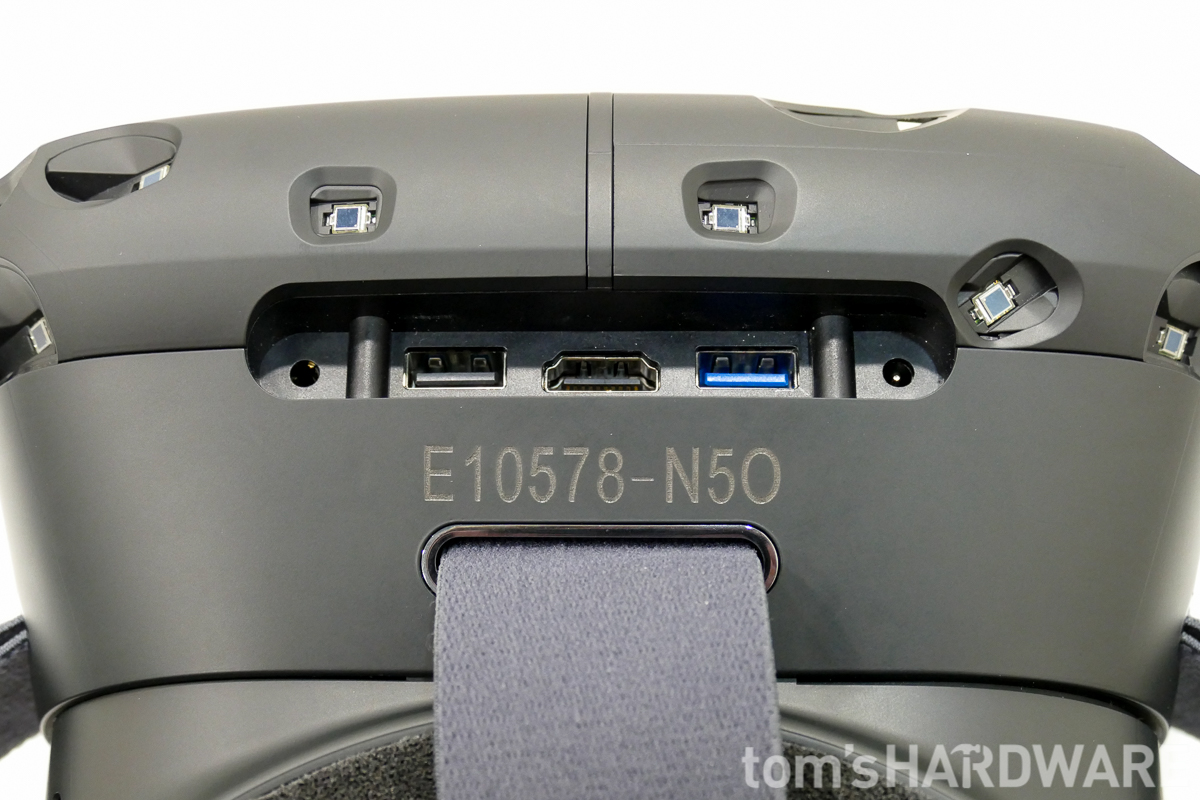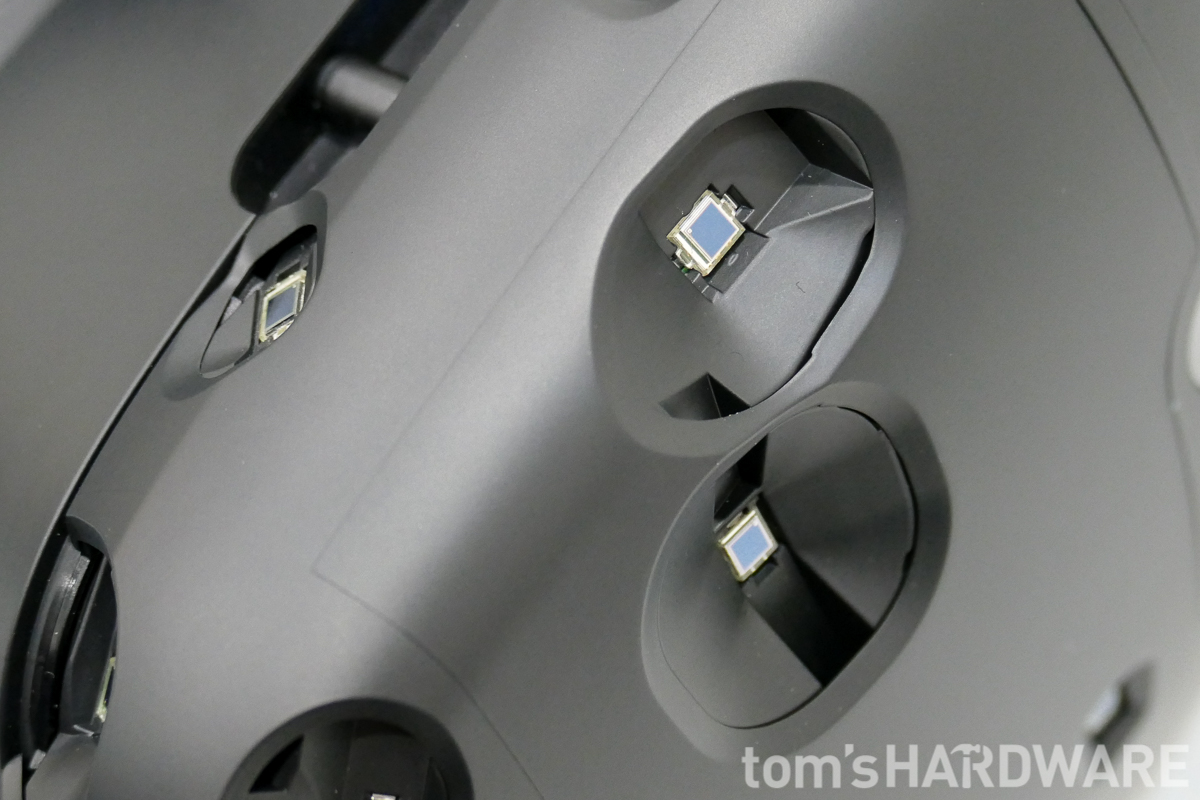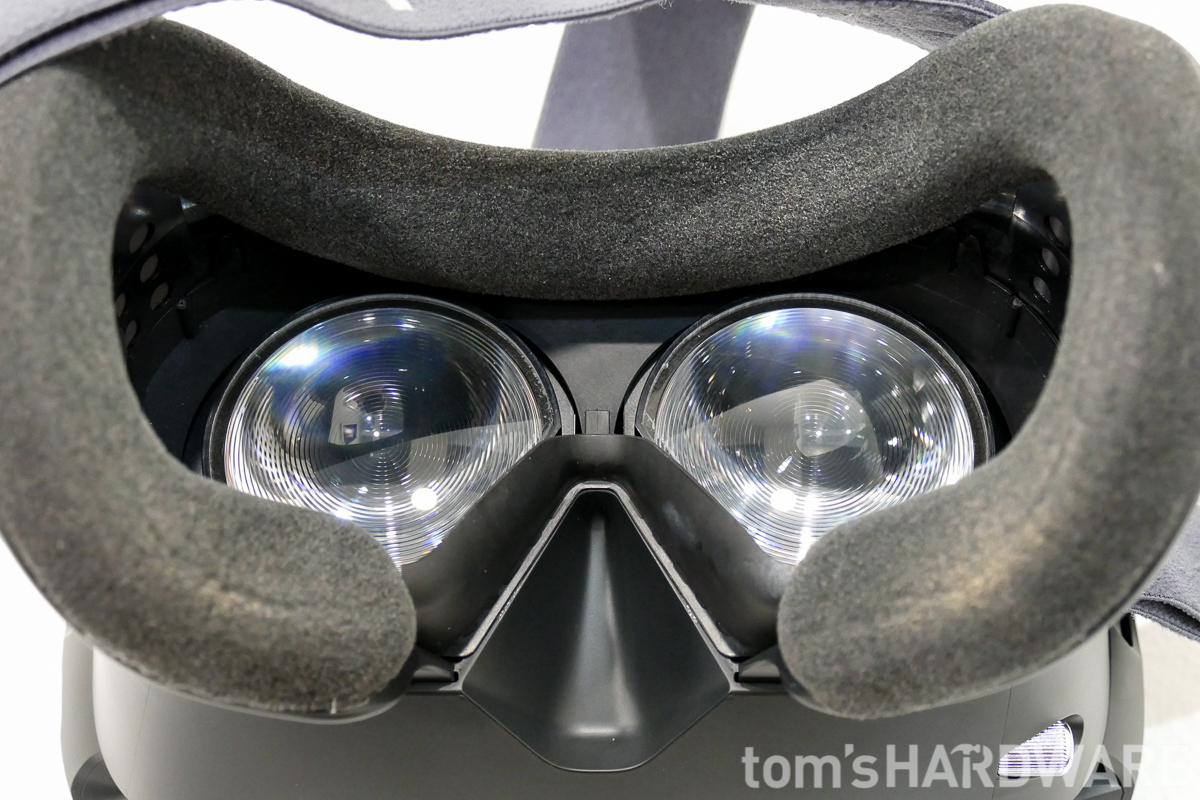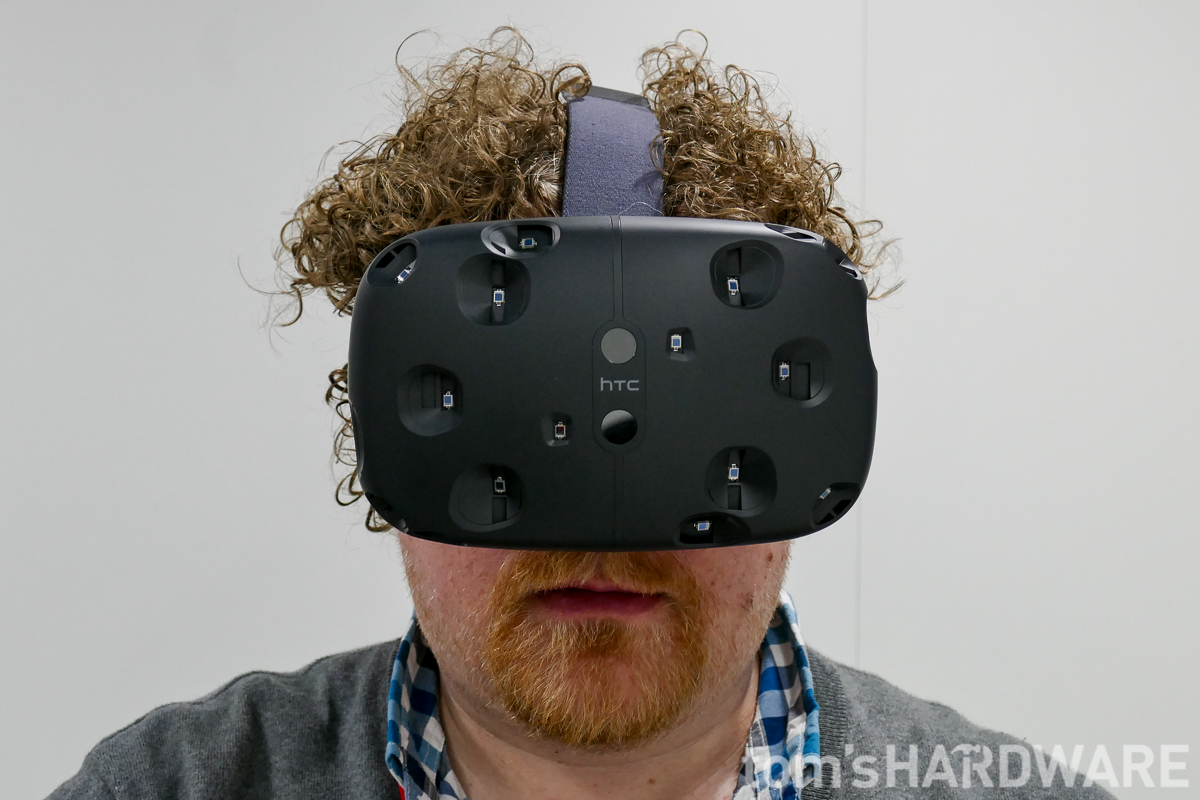Hands-On With The HTC Vive
The Hardware And Demo Setup
For the demonstration, I was taken into a room devoid of anything but the equipment needed to use Vive. There were no cameras allowed in the demo room, and the only hardware I could photograph was the headset itself, which you can see pictured.
The headset is connected to a gaming PC that I was told was running a single graphics card, probably a GTX980 or R9 290X – they wouldn’t divulge any additional details. Unfortunately, one of the weaknesses of the Vive prototype I tried was that it was connected to the PC with a lot of wires. The picture below shows that the prototype Vive is connected via HDMI, USB 2.0 and USB 3.0. I was told that future versions of the Vive will be connected with only one cable, but we are not sure if that is referring to the developer edition or only the full retail version. In order to keep the wires out of the way, I wore a harness around my waist that helped keep them manageable. While there were a few times in my demo where I did feel them getting in the way, it was only for a split-second until the developer running the demo moved them out of my way.
The other hardware that the Vive uses is a pair (to prevent occlusion) of laser-emitting "lighthouse" base stations that were positioned in the opposite upper corners of the room. Like the rest of the hardware, these were big prototype units that will shrink in size when the retail Vive is launched. These base stations work in conjunction with the 25 or so sensors on the headset to track its position. There are also additional sensors such as accelerometers in the headset that provide additional positional data.
The real star of the Vive’s show, and part of what makes it so special, are its SteamVR controllers. Unlike the currently controller-less Oculus Rift, the Vive’s controllers are integral to its experience. They are Wiimote-ish devices for each hand with a large hexagonal-shaped sensor array on top so they can be tracked by the same laser lighthouses that track the headset. The units I used in my demo were fairly rough prototypes with what looked to be 3D printed components, but more finished versions were shown at GDC (which we unfortunately did not photograph).
The controllers also have a clickable circular trackpad that sits under your thumb, a trigger for your index finger, and buttons on either side of their handgrips. These are activated by squeezing, though for the demos I tried I did not have to use these buttons. They also feature subtle haptic feedback and utilize the same advanced feedback system as the Steam Controller uses, with motors that can simulate difference forces, rather just having the controller simply vibrate. As mentioned above, they are wired into the headset, which is then wired to the PC, but I was told that the final release version of the Vive will have wireless controllers.
The sensors on the headset and controllers both work with the base stations to determine not only your head’s place in the environment, but also where your hands' and body's, and you can freely move around in the environment. This is what Valve and HTC are calling “360-degree room-scale VR.” For my demo, I was limited to a 15-by-15 foot space, which may seem small, but in the world of VR it's positively huge.
Since MWC, Valve has also clarified that the Vive is not limited to 15 x 15 feet, and the "room-scale" VR Valve is referring to is flexible and can be configured to fit different room sizes.
Get Tom's Hardware's best news and in-depth reviews, straight to your inbox.
While you are in the virtual space, the Vive indicates when you are about to get close to the edge of the physical playing area, so you don’t walk into a wall and hurt yourself. It does this by throwing up a glowing grid-like representation of your boundaries that subtly reminds you of your limits without being too distracting from the virtual experience.
The headset itself goes on like a scuba mask, with three stretchable straps. Because I haven’t had any experience with any other VR headset apart from the Gear, I can’t comment on how comfortable the Vive is in comparison to others. There was no discomfort for me while I used it and it was light enough that I soon almost forgot that I was wearing it.
In the headset you look through two Fresnel lenses, which are lenses that can be made with a wide aperture and short focal length without taking up as much space as a traditional lens. This is important when designing a headset to be a compact as possible. There are what looks like two cameras on the headset, which you can clearly see in our photos. We were told that they could potentially allow elements of the real world to be added to your virtual experience, or possibly used for depth sensing.
The last part of the hardware used for the demo was a set of over-ear headphones. These are not an integrated component, but just standard headphones that plug into an audio jack on the Vive headset. For me, the weakest link in the demo was the audio, because in the rush to get things going I don’t think they were put on my huge noggin properly. Because of this, the audio throughout my demo experience was sometimes muffled. I was not told if the final design will incorporate built-in headphones, and I did not learn anything about whether the Vive has 3D positional audio.
The Vive uses two screens (one 1080 x 1200 screen per eye for a total resolution of 2160 x 1200) that refresh at 90 Hz, which also then requires the PC hardware to maintain a constant 90 fps. Although this last feature isn’t controlled by the Vive itself, you can be sure that the minimum hardware specs recommended by Valve and HTC will be high enough to ensure that it can push that framerate in every SteamVR title.
Although Valve and HTC have not disclosed the Vive’s field-of-view, from my understanding, its horizontal FoV is equivalent the latest Oculus Rift and Sony Morpheus. However, one major difference between Vive and other solutions is that the screens for each eye are taller than wider, being portrait-orientated.
The screen-door effect of the Vive’s resolution was also noticeable when I first put it on, and I was worried that it would impact my experience. However, as soon as the demos started and all the other aspects of what makes Vive so great came online, such as the hand and body tracking, the lack of peripheral vision and resolutions issues were no longer noticeable. The sense of presence and the immersion level of Vive is so great that it overpowered any other technical issues that may exist in the prototype.
I will say that the statement by Gabe Newel that no one using the Vive gets motion sickness is mostly likely accurate. Due to its 90 Hz refresh rate and incredibly accurate motion tracking, at no time during my demo did I feel any nausea, and I am someone who often gets motion sickness in real life.
Although its specifications are already very good, between now and the release of the final consumer model HTC and Valve have the chance to improve the Vive’s hardware. That means there’s a chance we’ll see improved specs, such as screen resolution and FoV, in the consumer model.
Current page: The Hardware And Demo Setup
Prev Page I First Experienced VR In Barcelona Next Page The Demos-
CaedenV It is going to be pretty hard to figure out which VR headset to pick up next year. First I need to get a newer GPU to drive one though... no way my old GTX570 is going to be pushing two 1200p+ displays, especially at 90Hz lol.Reply -
spladam You cried? They moved you to tears with this tech? It sounds cool, but how do you know you are not still in VR?Reply -
zerghumper Ok here's my question and no article on the Vive / Valve VR that I've read so far has answered it:Reply
Will games have to be written from the ground up to support the Vive, or like the Oculus Rift, can support be modded into a game? I know most of the features Vive brings to the table wouldn't be supported, but what about head-tracking? This is the one reason this decision is so difficult for me. I keep seeing developers being blown away by the Vive, but I wonder, will I be able to use it to go play minecraft, STALKER, Alien Isolation, and other games that already do support the Oculus?
Either way this future excites me and I can't wait to see what games get made with this system in mind! -
DelightfulDucklings The main thing I want to know is if there will be a Vive that excludes the movement sensors as I personally don't have the space where my PC is setup to stand up and move around at all so I will be only able to sit. I'm sure they must have thought of this but I just haven't seen it mentioned muchReply -
Hector M Torres Sitting inside a giant MecWarrior or flying a Space Fighter ( with simulated full 360 degree range of view/movement will be awesome ) , Tank battles , flying Jet fighters, i can see a few great games made so much better with this new tech,I can't wait !Reply -
alex davies ReplyOk here's my question and no article on the Vive / Valve VR that I've read so far has answered it:
Will games have to be written from the ground up to support the Vive, or like the Oculus Rift, can support be modded into a game? I know most of the features Vive brings to the table wouldn't be supported, but what about head-tracking? This is the one reason this decision is so difficult for me. I keep seeing developers being blown away by the Vive, but I wonder, will I be able to use it to go play minecraft, STALKER, Alien Isolation, and other games that already do support the Oculus?
Either way this future excites me and I can't wait to see what games get made with this system in mind!
The Vive use's Valve's SteamVR platform, which is a set of APIs that any developer can support in their games, and any or all aspects of the platform can be incorporated. So if there is a game that just needs to use the Vive's head-tracking feature, there is no reason a developer can't just support that one feature.
From what I understand the Vive is the first of hopefully many solutions built on SteamVR. There may be different versions of the Vive from HTC themselves (such as a kit without the controllers etc.), or there may be cheaper headsets from other manufacturers that are built on SteamVR.
Either way, I think if one is questioning if games that currently support Oculus now will also support SteamVR in the future, I would say most definitely. That is, other than platform exclusives, which there surely will be a few of -- for example, I'm pretty sure EVE: Valkyrie will be Oculus and Morpheus only. -
alex davies ReplyThe main thing I want to know is if there will be a Vive that excludes the movement sensors as I personally don't have the space where my PC is setup to stand up and move around at all so I will be only able to sit. I'm sure they must have thought of this but I just haven't seen it mentioned much
I'm sure there'll either be a Vive starter kit minus the controllers, or another OEM will partner with Valve to make an entry-level SteamVR headset for sit down only gaming experiences.
-
gaborbarla Interesting read Alex, I think now you need to quickly go and test the latest version of Oculus and give us feedback on it. I have disappointing review of the Vive before and glad to hear that you found the opposite. I really want this technology to succeed and we need fast and accurate tracking, high Hz, Hi-res screens, and no motion sickness. From your article it seems like they are on track with achieving this. Hope they don't scale it down due to commercial reasons. I rather spend 500-1000USD and get something decent. Anyways a comparison to the competitors from your perspective would be great. If I remember correctly the Vive requires some sensors/reflectors to be installed in the room where you use it which is something that we can get rid of eventually for sure.Reply -
cats_Paw Ill wait untill there is a comparison by someone who I can call unbiased (dont know this reviewr, but Id better make sure).Reply
I will buy a VR, no doubt, but want the best one, even if I have to overpay a bit.
I want to run it at high fps, no motion sickness, etc etc etc.
Then I will fire up crysis for my unsuspecting new lady friend :D.
